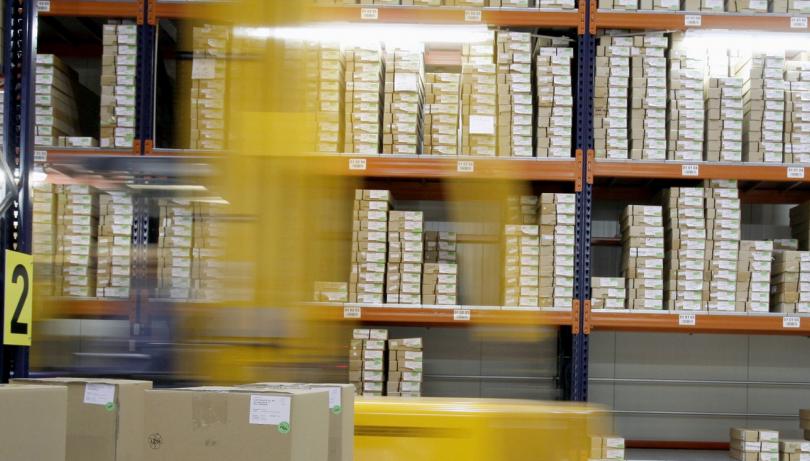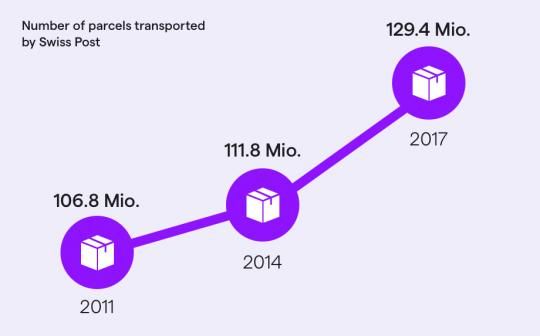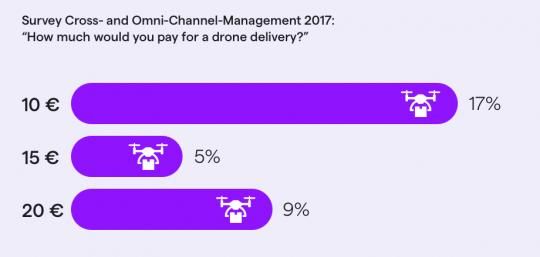Logistics innovation: Fighting for the last mile
The increasing online trade inevitably leads to an increase in parcel shipments. The parcels not only run in one direction from the retailer to the recipient but often also back, which puts logistics under enormous pressure.
Although the business model of online merchants is based on the fact that receiving parcels is generally more pleasant than returning them, online shoppers in Germany alone send back a three-digit million number of parcels. The return rate in the fashion business is particularly high, with Zalando, for example, having an average return rate of 50 percent across all divisions, the company reported.
The fleet of delivery vans operated by Swiss Post and UPS, DHL or Fedex, which deliver online merchants' parcels to customers, is growing, and with it the congestion on the already congested roads. With Amazon's official market entry in Switzerland and its cooperation with Swiss Post with regard to customs and tax processing, the number of items made available to Swiss customers has increased many times over. Find out more in our next article about how Amazon wants to conquer the retail trade.
In addition, consumers are becoming more and more demanding and want their order to be picked up or delivered on the same day. Retailers are faced with the challenge of adapting their logistics to these changing conditions. Those who do not master this will not grow even with the most attractive online shop.
However, logistics is material-intensive and requires significant investments. For example in warehouses, delivery vans or distribution centres. Brack.ch not only handles its own logistics at its Competec logistics centre in Willisau, but also those of its competitors. Of course, the traditional hauliers would like to be at the forefront of this issue, because after all it is all about maintaining their core business. At the same time, start-ups are entering the market with innovative ideas. In the following, we present various approaches and concepts on how to get this logistics problem under control.
Intelligent letterboxes facilitate parcel delivery
This problem is known to many, but difficult to avoid: due to the overlapping of working and delivery times, parcels are often delivered when you are not at home. This is cumbersome for the recipient, who has to take the detour to the post office to collect the parcel. It is also annoying for the deliverer who loses valuable time by waiting or the subsequent detour to the post office. And the post office also comes under pressure when there is an almost unmanageable rush of parcel recipients to pick up their parcels after work. To solve this problem, DHL has been testing intelligent parcel boxes in Germany for a few years now.
The principle is relatively simple: both recipients and DHL deliverers can access the corresponding parcel box using an RFID chip or hand scanner (the latter only for deliverers) and insert or remove parcels. In this way, deliveries can be delivered safely and without any problems, even if the recipient is not at home. Not only senders and recipients benefit from this solution, but mailbox manufacturers also benefit from a lucrative new business and the opportunity to act as a pioneer in the field of logistics innovation. To ensure that the product range remains reasonably clear, the major suppliers are currently debating uniform standards. Nevertheless, DHL has not yet shown any willingness to open its own boxes to competitors. About two years ago, Swiss Post also announced a pilot test with 200 test customers, but then suddenly put the plans on ice.
Goods traffic in underground hubs to relieve congested roads
80% of freight transport in Switzerland is by road. Congestion is the order of the day. Blocked roads or delays automatically increase the costs of traders who traditionally struggle with low margins. To tackle this problem, Coop and its competitor Migros are committed to the "Cargo sous terrain" project. With this project, the two retailers and their cooperation partners have set themselves ambitious goals to reduce bottlenecks on motorways, railways and urban roads in the long term. In less than 30 years Cargo sous terrain wants to implement an automated overall logistics system with economic and ecological benefits. Goods traffic is handled via the so-called underground hubs. The goods are to be transported from one hub to another at a maximum speed of 30 km/h. The new system is designed to provide a high level of safety for the passengers. The first section of 67 kilometres, a connection from the Post Parcel Centre in Härkingen to Zurich city centre, could theoretically go into operation as early as 2030. The final stages of the delivery will then be taken over again in the traditional way via the post office and other delivery agents.
Logistics innovation from start-ups
For start-ups, the logistics sector offers many opportunities for the development of innovative concepts. The German startup Pakadoo, for example, addresses the problem already mentioned, namely that parcels are usually delivered when you are not at home. With Pakadoo, the ordered goods arrive where you are during the day anyway: at the workplace. The startup coordinates the deliveries via the Pakadoo software and the Pakadoo service platform in such a way that the packages - marked as private - are delivered to the company Pakadoo point. The recipient receives an online message and can pick up their parcel. The prerequisite for this business model, however, is the employer's willingness to offer the delivery of private parcels as an "employee benefit" and to set up corresponding Pakadoo Points. This is particularly worthwhile for large companies. For example, in April, following a pilot phase, Deutsche Bahn introduced the Pakadoo service at six locations throughout Germany to make a contribution to the work-life balance of its employees. Another positive effect is the associated bundling of parcel delivery services. This relieves traffic and reduces CO2 emissions.
The Swiss start-up company Annanow is also addressing the issue of deliveries over the last mile. While the feasibility and profitability of "same-day delivery" is still the subject of heated debate, Annanow is already making it possible to deliver parcels within 60 minutes - "one-hour delivery" so to speak. This works thanks to the crowd principle behind it: anyone who is already on the move in the city can pick up shipments. But you have to introduce yourself personally to the company and register first. The parcel hero can decide spontaneously whether he wants to take over the delivery. Swiss customers pay between CHF 10 and CHF 25 per collection, depending on the delivery radius. The customer orders the desired goods in the corresponding shop, which has the delivery handled by Annanow. Annanow takes care of the connection of their software to the shop's IT system, whereby the service is currently only possible in cities. The courier accepts the order via the Annanow App and collects the shipment promptly from the shop. The app accompanies the courier through the entire delivery process. The German logistics giant DHL has also been experimenting with crowdsourced parcel delivery for some time now: via the MyWays platform. Recipients can order free amateur couriers to pick up their parcels at DHL service points.
Is Switzerland lagging behind?
There are some efforts in Switzerland to develop logistics innovations. For example, SBB has been active in the field of digitisation for some time now and works together with various start-ups. Since 2016, industry leader Kühne + Nagel has been involved in the "Smart Transportation & Energy" start-up boot camp, in which SBB Cargo is also participating. With this cooperation, Kühne + Nagel wants to exchange ideas with young companies in order to gather innovation impulses for its own core business. Nevertheless, such initiatives are rather rare in the Swiss logistics industry and a general rethink is slowly taking place. The exchange within the Swiss logistics scene is rather sparse, which will have an impact on the competitive situation over time.
In the summer of 2018, Swiss Post launched drone test flights in cooperation with the globally active US company Matternet. According to Swiss Post, it is one of the first companies in the world to try out autonomous drone logistics for commercial applications. Although the drone is still having acceptance problems in Europe, there are some supporters who are prepared to dig deeper into their wallets for an extra fast drone service. This is particularly pronounced in Switzerland. In a survey conducted as part of the "Cross & Omni Channel Management 2017" study, 17 percent of respondents in Switzerland said that they would pay 10 euros for a drone delivery, 5 percent would find 15 euros acceptable and 9 percent would even pay 20 euros. Retailers, on the other hand, are more skeptical. According to Galaxus, the hurdle lies in the lack of flight regulation; at best, there are opportunities for drone flights in rural areas. Drones are also not yet an issue for Coop@home or Microspot.
Another sensible approach to tackling the logistics problem and relieving the burden on the roads is to create consolidation hubs outside the city centres. Parcel deliveries are centralised there and then delivered together. In China, the situation has already progressed in some places. There are cities that have transferred the responsibility for delivery exclusively to one company. DHL developed such a consolidation center for Heathrow Airport in London. The flow of goods comes together there before being redistributed. Markus Kückelhaus, Vice President of Innovation and Trend Research at Deutsche Post DHL Group, sums up this development as follows: "In the long term, such an "orchestration of urban supply" is probably needed. Logistics service providers must actively deal with the new conditions by developing new concepts in which they can take advantage of digitization as part of their business model. Be it merely in the area of process improvement or a step further through the development of new innovative service offers and thus the creation of new opportunities for monetization.
Photo by delphinmedia on pixabay.





